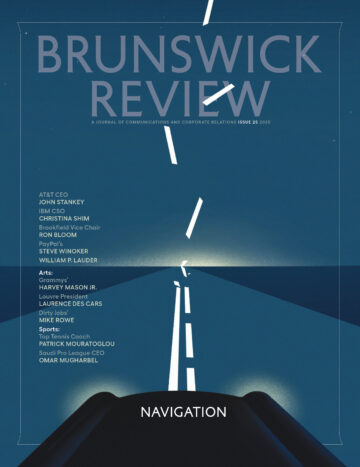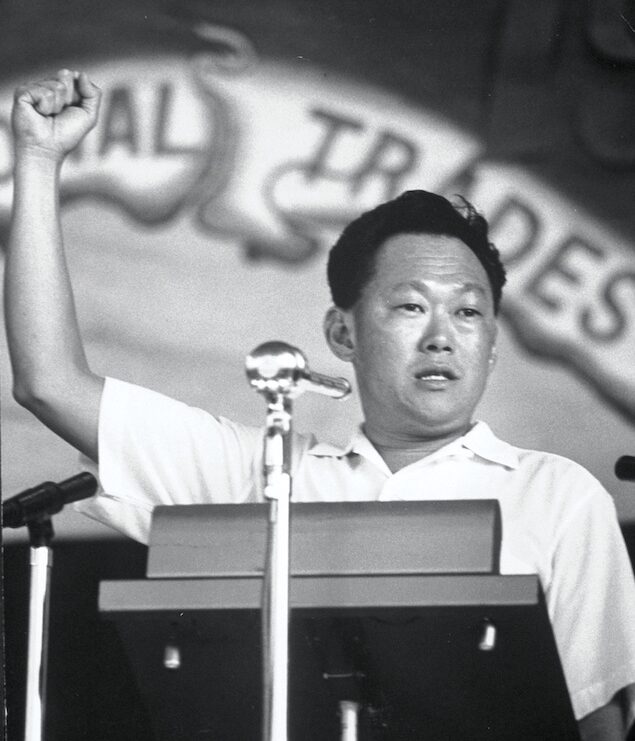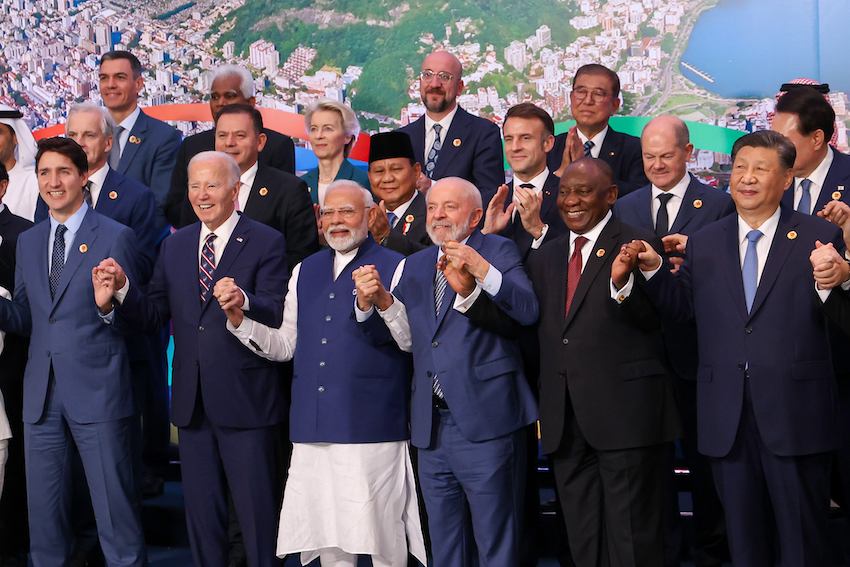Navigation in uncertain times calls for informed, creative leadership and a commitment to the long term, says Sir Alan Parker, Chairman of Brunswick Group.
The compass, invented by the Chinese during the Han Dynasty, was first used as a fortune-telling device before it became the sailor’s most trusted resource. That origin seems strangely appropriate, almost poetic in these times where the requirement to show leadership in organizations is greater than ever. So much is uncertain, but we must still chart a course. Major decisions may be informed by more data than ever, but in changed conditions, all of our precedents are less relevant.
We have taken the theme of Navigation for this edition of the Brunswick Review precisely for that reason. CEOs and leadership teams now find themselves at the helm of organizations navigating constant disruption. Leadership today is no longer simply about managing operations or driving efficiency, but about charting a course through uncertainty.
Since the dawn of humankind, navigational skills have developed that have allowed our species to thrive, to adapt to new and changing environments, to seek new fortunes. Our anchors were fixed points—milestones, islands, coastlines. The Egyptians guided their boats by the movement of the Sun. The Phoenicians, the early masters of open sea voyages, used our North Star.
Where are the fixed points in our current corporate and political universe? Fast and often conflicting changes create actual or potential crises on many more fronts. What were once seen as occasional storms of significant threats and crisis are now an expected part of normal affairs, a whirlwind of storms. Whether it’s technological upheaval, geopolitical tension, shifting social expectations, or environmental urgency, today’s leaders must make high-stakes decisions with incomplete information and compressed timelines. Where do we turn for our truest North Star?
In our work with leadership teams around the world, the first responses we saw were organizations tuning up their radar and asking for more scenario planning with a much wider set of inputs and outcomes. As US General and President Dwight D. Eisenhower reportedly said about preparing for battle, “plans are useless, but planning is indispensable.”
Alongside that widening of the leadership radar, we have also seen much greater attention to investment in rapid-response capabilities. For clients in multiple markets, social media has combined with whipsaw social and geopolitical shifts to exponentially multiply the need for rapid responses. That need seems to only increase with each passing year. Bad news—even fake news—has never traveled further or faster or has been more capable of a detrimental impact.
It is not just about surviving the storm but about steering toward a new destination with a boldness fitting the new environment.
But every crisis offers new opportunity. This crush of social media pressure can also be seen as an opportunity for better engagement, a new channel for direct communications. The problem is that so much of corporate content online is inadequate and opaque, unprepared for this moment. It does not build-in how the outside world sees or talks about an issue. What we have seen is leadership, in a crash course, becoming much more sophisticated in the digital engagement possibilities, even in activities as simple as LinkedIn.
In times of turmoil, leadership will instinctively reach to improve resilience in operational systems and financial capital. Capital Markets communications and Investor Engagement are areas where we see rapid change as the markets are changing. But alongside our work in these we believe two other types of capital are crucial, whether you are an organization or an individual. These are your reputational capital and your relationship capital. Both of these evolve naturally, for better or worse, whether we pay attention to them or not. But increasingly there are better tools that allow you to invest and grow these forms of capital more deliberately.
Investing in your reputational capital means acknowledging that most people will never know you in person, but through what they have read or heard, through media or their personal networks. We all form quite strong opinions about people we have never met. Reputational capital consciously cultivates those opinions as a resource, knowing that these internal or external stakeholders, in some critical situations, can be very influential.
Relationship capital is the power of people who actually know you. Their power is often exponentially greater, as they will have an authority over the opinions of others and be able to help build a support base that can stand up for you in the tough times. These relationships are immensely valuable. Leaders should consider what form of capital might be required for a bold move that needs support, or for defense when there’s an incoming problem or crisis. As Samuel Johnson once said, “A man, Sir, should keep his friendship in constant repair.”
There is a perception out there that leadership is inclined now to lay low, to avoid getting caught up in polarizing issues where they could find themselves under attack for well-meaning positions. But what we have seen instead is that public positions are being approached with a new thoughtfulness and an awareness of impact. Business leadership can be a powerful shaper of society. The decision of when and how to use that power, to take a stand on an issue, is not one most leaders can afford to ignore, even as they seek to avoid becoming a target of unnecessary controversy.
This is not a short-term set of changes and, for some time, uncertainty will remain the only certainty.
Taken as a whole, these responses to the new environment are all reasonably predictable. What has been significantly more surprising is how much more often we are finding leadership teams beginning to think, plan and act for the longer term. This is driven by a two-pronged narrative: First, that the current level of instability cannot continue forever, and second, that a radical environment permits more radical thinking toward solutions. It is not just about surviving the storm but about steering toward a new destination with a boldness fitting the new environment. Increasingly, we see transformation strategies emerging—not in defiance of current conditions, but in response to them, as a navigation strategy. Leadership teams are seeing change as a force to be embraced and celebrated, not resisted.
Of course, many of these transformations involve technology. AI is a ubiquitous added dimension in the fabric of our work. Its implications for capital allocation, productivity and the shape of organizations are unclear. If Professor Scott Galloway is correct and AI is an Ozempic for organizations, then we have to assume we are currently still on a low dose. There is “silent slimming,” but it is hard not to believe exponential change is coming and will have a serious impact on employment. As in many other areas though, prediction here is not getting any easier.
One of the most important and reassuring lessons we have learned in our conversations, and one that comes through clearly in this issue, is that navigation and leadership are not solitary endeavors. Stakeholders are not just passengers but are part of the crew—and every member of the crew is involved. They have voices and talents that can amplify or disrupt your momentum. The leaders who navigate best are those who listen deeply, build trust intentionally, and create cultures that are agile and purpose driven.
We can be certain that, with such difficult decisions ahead, building teams that can be as honest and authentic as possible is critical. In the new environment, you have to build-in the expectation that every decision will be observed, with an intense scrutiny on the “why” as well as the “what.” Being clear about the motives behind any action as well as the likely outcomes will be more crucial than ever.
We are working on the basis that this is not a short-term set of changes and, for some time, uncertainty will remain the only certainty. There is a huge amount of energy. Some of it takes the shape of anxiety, as we are aware of problems all over the world, brought to us by new media immediately, often live as they happen. And some of that energy naturally arises from appropriate caution or concern for the potential impacts and management of rapid change. But some of it is, as well, pure excitement
and anticipation.
What we find deeply reassuring is that we see leadership recognizing the benefits of deeper engagement with all of their stakeholders, not just “hit and run” communications. Leaders are becoming more comfortable working in this new, more unpredictable environment. They are taking the opportunity to create value through investing in building trust and cohesion in ways that will create more positive innovation and change. In this way, they are plotting a new course, looking beyond the challenging present towards a stronger long-term future.
More from this issue

Navigation
Most read from this issue

AI for President





